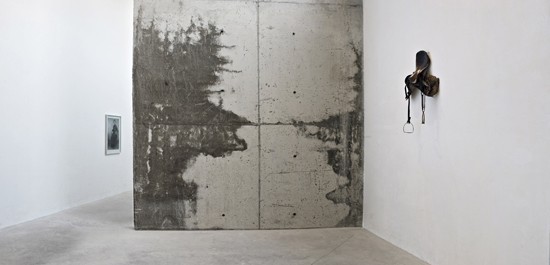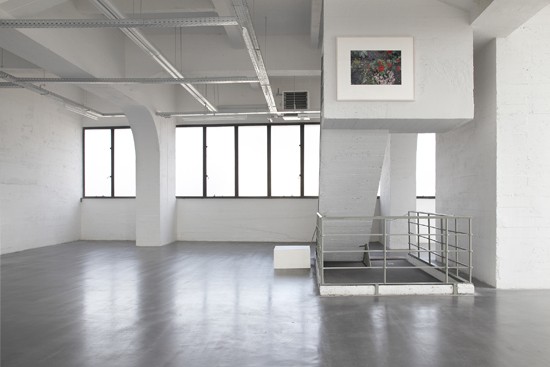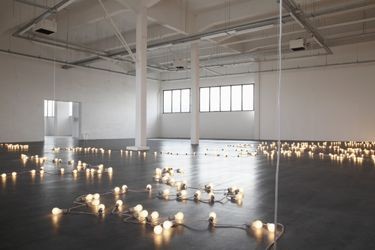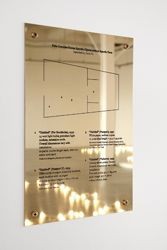 Galoppa! (2009), installation view in the solo exhibition “Last Fuck” at Galleria Zero, Milan, 2009. Work details: one saddle, two framed documents (the riding saddle of bishop Peter Tran Thanh Chung who ministered to the indigenous people in the Central Highlands of Vietnam between April 1958 and August 1966, and who was the last missionary to use horses for this purpose, and a loan agreement from the Diocese), saddle 100 x 70 cm; framed documents 49.5 x 39.7 cm each. All images: Unless otherwise noted courtesy Danh Vo and Galerie Isabella Bortolozzi, Berlin.
Galoppa! (2009), installation view in the solo exhibition “Last Fuck” at Galleria Zero, Milan, 2009. Work details: one saddle, two framed documents (the riding saddle of bishop Peter Tran Thanh Chung who ministered to the indigenous people in the Central Highlands of Vietnam between April 1958 and August 1966, and who was the last missionary to use horses for this purpose, and a loan agreement from the Diocese), saddle 100 x 70 cm; framed documents 49.5 x 39.7 cm each. All images: Unless otherwise noted courtesy Danh Vo and Galerie Isabella Bortolozzi, Berlin.(Intimacy)
ART iT: We were talking about the opacity of language. The language of contemporary art itself can also be opaque. The first work of yours I saw in person was the saddle piece in the 2008 Yokohama Triennale, and then in 2009 I saw the Kunsthalle Basel show that included the chandelier from the Hotel Majestic. In a way your work reads as latter day minimalism, but in a way it’s completely different. Do you yourself connect it to any pre-established language of contemporary art?
DV: I do. In many ways I’m very opportunistic, so I try to think of spaces and their qualities – and I think for exhibition spaces the initial quality is the opaqueness. You go there and you just don’t get any information, and that is what I want to use as a spring because that is very much what my work is about. My work seems like it’s giving information, but it’s not.
On the other hand, I put effort into publications about my work like catalogues, or even interviews and articles, because I also perceive them in terms of space and want to think about how we can use these spaces. An interview may be a space where I am providing a lot of information, but I don’t necessarily see it as a separate thing. I try to see what fits where, and if it turns out that some information gets removed, it’s not because I’m afraid of it or dogmatic. I just think we should work with contradictions and what comes from them.
ART iT: In the case of Basel, if someone went through and looked at the objects but did not read the identifying texts you included on the brass plaques in the exhibition, do you think they would still have gotten something out of it?
DV: I think the text is an important part. I haven’t found a solution for the situation you describe, but I believe that texts provide a key, as well as a title. In the end the Basel texts were just the captions for the works, with the titles and descriptions. It’s a balance that I’m working on – how much information do I actually give?
There’s nothing new under the sun, it’s a strategy that has been used for a long time. It’s a way of emphasizing objects. It’s like Richard Prince. It’s “Untitled” with a title. That opens things up, and of course many artists have used it afterwards, like Felix Gonzalez-Torres.
ART iT: Was Felix important for you to formulate your own approach? You have previously made works using Felix as a reference.
DV: Yes, and I was also involved in the curation of the retrospective at the contemporary art space Wiels in Brussels in early 2010, “Specific Objects without Specific Form.” I was obsessed with Felix’s work when I started, as many people have also been. It’s a bit scary.
I think I respond to the contradictions in his work – the schizophrenia, the perversity. It started very simply. The first work I saw was one of the candy pieces. Like anybody else, I took a candy and ate it. Then I started to research Felix’s work and read his interviews, and I liked that it was this thing that could and should disappear, but of course my first thought was to blame myself for not keeping the candy. It was such a weird experience to recognize this contradiction embedded in the action, and I thought it was really special for an artwork to have that capacity.
 View of the Felix Gonzalez-Torres works “Untitled” (Alice B Toklas’ and Gertrude Stein’s Grave, Paris) (1992) and “Untitled” (Passport) (1991) as installed by Danh Vo in the second version of the exhibition “Felix Gonzalez-Torres: Specific Objects without Specific Forms” at Wiels, Brussels, 2010. Photo Sven Laurent, © The Felix Gonzalez-Torres Foundation.
View of the Felix Gonzalez-Torres works “Untitled” (Alice B Toklas’ and Gertrude Stein’s Grave, Paris) (1992) and “Untitled” (Passport) (1991) as installed by Danh Vo in the second version of the exhibition “Felix Gonzalez-Torres: Specific Objects without Specific Forms” at Wiels, Brussels, 2010. Photo Sven Laurent, © The Felix Gonzalez-Torres Foundation.ART iT: It inserts something instinctual into the space of contemplation. Perhaps you visit an art space to contemplate works and try to preserve something of that experience in your memory, but then the candy switches your focus onto something base, consuming the consumable.
DV: Felix is one of the only artists whose work continues to shock me the more I learn about it. It’s also the condition of having AIDS – if you know that you’re going to die within some years, you could just plan out your whole production, something I would never be able to do. There’s one poster stack that is not reproduceable, which he called “Untitled” (Implosion), or he signed one snapshot from among a group so that one picture would be an artwork but the rest not, and this snapshot is of two toy figures together on a bed, in contrast to the billboard piece with the empty bed. There’s all these twists.
I wrote a text on his piece “Untitled” (Alice B Toklas’ and Gertrude Stein’s Grave, Paris) (1992). This work is a masterpiece, because of course the discussion – which was also a big part of his agenda – was to examine the nature of publicness, and the piece itself is a just a picture of flowers. When I went to see the actual grave in the Cimetière du Père-Lachaise in Paris, I already knew the story that Alice B Toklas died 20 years after Stein and decided to be buried alongside her, and thought that was the reason why Felix took the picture. But the grave itself is a one-person plot, very anonymous, and only Gertrude Stein’s name is on the headstone. It was by pure coincidence that I walked around the grave and noticed that Toklas had her name engraved on the backside. I think that when Felix saw this gesture it must have been a blast for him, but instead of taking a photo of the tombstone he took a picture of the flowers, as a decoy. Then he put Toklas before Stein in the title, reversing the relationship so Toklas becomes the hero.
The piece itself is amazing but in regard to Felix’s production and all the discussion about how he makes his private life public, it also shows he is capable of internalizing public moments. These contradictions are the beautiful thing about his work.
ART iT: Do you also like the idea of the decoy in your own work?
DV: Sometimes I do, sometimes not. I think Felix once said that the way he makes art depends on which leg comes out of the bed first. Sometimes he’s happy, sometimes he’s mad at the world. After making works scaled to the weight of his boyfriend, the weight of his father, he can make a work called “Placebo” or “Revenge.” It’s beautiful because sometimes you believe these candies mean something, sometimes it’s just shit. I think this honesty is a good starting point.


Left: View of the Felix Gonzalez-Torres works “Untitled” (For Stockholm) (1992) and “Untitled” (Passport II) (1993) as installed by Danh Vo in the second version of the exhibition “Felix Gonzalez-Torres: Specific Objects without Specific Form” at Wiels, Brussels, 2010. Photo Sven Laurent, © The Felix Gonzalez-Torres Foundation. Right: Brass plaque made by Danh Vo with floorplan and works list for the exhibition “Felix Gonzalez-Torres: Specific Objects without Specific Form” at Wiels, Brussels, 2010. Photo Sven Laurent.
ART iT: Were there other artists that were important for you when you were starting off?
DV: They came later. When I started, he was the only one I was studying. I was a stalker. I think the really good artists are those that know they are going to die. They create a radicalism that’s so wild, letting it all go. This is what we really lack today. So something good did actually come out of AIDS.
Danh Vo: A Five-Part Dossier on How Things Live
